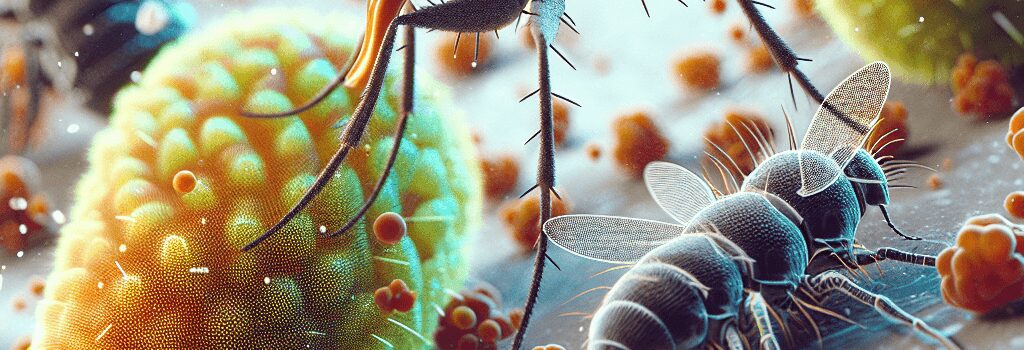Fruit Flies’ Defense Against Parasitic Mites

Have you ever battled insomnia fueled by anxiety or doom-scrolling at 3 am? In Queensland’s orchards and rainforest canopies, certain Drosophila melanogaster populations wage a far more visceral nightly struggle: staying awake to avoid being eaten alive by ectoparasitic mites. A new study from the University of Cincinnati, led by biologist Joshua Benoit, reveals how artificially selected mite-resistant flies forsake sleep at a steep metabolic cost, trading energy reserves and normal circadian rhythms for survival.
Parasite-Driven Insomnia in Drosophila
In their natural habitat, fruit flies are besieged after dark by Gamasodes queenslandicus mites, which attach like ticks, pierce the cuticle, and consume hemolymph and tissue. Parasitized flies exhibit immune overactivation, tissue damage, and reduced mating success. To counter this, Benoit’s team used artificial selection over eight generations to breed lines of flies demonstrating heightened nighttime activity in the presence of mites.
- Behavioral assays were conducted in custom 16-lane LED arenas, with infrared motion tracking at 30 fps.
- Respirometry measured oxygen consumption at ~5 µL O₂/fly/hour under flow-through conditions.
- Sleep bouts shorter than 5 seconds were defined as wake periods, consistent with established Drosophila sleep research.
Metabolic Trade-Offs and Gene Expression
RNA-seq profiling of whole-fly extracts revealed upregulation of over 30 genes in glycolysis, lipolysis, and proteolysis pathways. Key enzymes such as hexokinase, glyceraldehyde-3-phosphate dehydrogenase, hormone-sensitive lipase, and cathepsin L exhibited 1.5–2× higher expression in resistant lines. Quantitative PCR validation confirmed elevated transcription of period and clock genes altered downstream of energy sensors like AMP-activated protein kinase.
Consequence: resistant flies show a 20% reduction in body fat and 15% lower protein reserves. Elevated basal metabolic rate and nocturnal activity levels matched diurnal controls, supporting a model in which hypervigilance requires constant ATP turnover and oxygen consumption.
Methodological Advances in Studying Sleep-Parasite Interactions
Beyond classical behavioral assays, the study employed:
- Micro-CT imaging to visualize mite attachment sites and quantify tissue damage.
- CRISPR/Cas9 knock-in reporters for real-time monitoring of neuronal activity in the mushroom bodies.
- Automated machine-learning classifiers to distinguish grooming, flight attempts, and grooming behaviors from true sleep bouts.
These innovations enable high-throughput screening of genetic variants and pharmacological modulators of sleep and immune function.
Genetic and Neurobiological Mechanisms
Sleep regulation in Drosophila is orchestrated by a conserved network of clock neurons, neuropeptides, and neurotransmitters. Electrophysiological recordings revealed that resistant flies have elevated baseline firing rates in wake-promoting dopaminergic PPL1 neurons, along with reduced levels of sleep-inducing octopamine. Transcriptomic shifts in the insulin/TOR pathway suggest systemic hormonal cues link energy status to sleep drive.
Ecological and Evolutionary Implications
While chronic sleeplessness impairs long-term survival in controlled lab settings, in the wild the fitness gain from avoiding lethal parasitism likely outweighs the cost of lost rest. Modeling studies predict that when parasitism risk exceeds 60% per night, selection favors hypervigilance despite a 30% increase in starvation probability.
Similar behavioral adaptations have been noted in roosting bats and migratory birds, where external parasite pressure alters sleep architecture. These cross-taxon parallels hint at a universal trade-off between immune defense and energy conservation.
Expert Perspectives
Dr. Anjali Rao, entomologist at the Australian National Insect Institute, comments: “This work elegantly links behavior, metabolism, and gene regulation, revealing a sophisticated survival strategy. It underscores the importance of considering ecological context when studying sleep in model organisms.” Dr. Michael Leitner, neurogeneticist at Max Planck Institute, adds: “The integration of CRISPR reporters with respirometry sets a new standard for dissecting the neural basis of state-dependent behavior in Drosophila.”